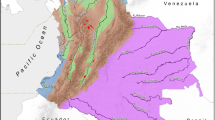Abstract
Globally, the most widely used wetland classification is that adopted by the contracting parties of the Ramsar Convention, which is the Convention on Wetlands of International Importance especially as Waterfowl Habitat. A review of the Inland Wetland component of this system shows that mixed criteria are used to separate the wetlands, and that not all natural inland wetlands have been addressed. A classification system using landform and hydro-period, which results in 13 primary geomorphically “non-emergent” types for natural wetlands, is proposed to describe the full variety of wetlands at a primary level around the globe, and is suggested to be incorporated as the first-tier of the Ramsar classification.
The proposed classification has been designed so wetlands can be described, classified and compared systematically. This paper attempts to reconcile the Ramsar Classification system with the proposed approach. The intention in this paper is not to displace the Ramsar Classification, but rather to indicate its inherent underlying geomorphic structure, and hence re-order its hierarchical framework. This adjustment to the existing classification system would highlight underlying similarities between wetlands so that global comparisons can be more readily made. It also has considerable advantages for a staged, systematic discrimination and classification of the vast array of differing wetlands globally.
The use of geomorphic and hydrologic elements as the primary and secondary divisions with the more commonly used Ramsar Classification terms as a tertiary division, provides a logical structure to compare and contrast wetlands globally.
Similar content being viewed by others
References
Allaby, A. and Allaby, M. 1990. The Concise Oxford Dictionary of Earth Sciences. Oxford University Press, Oxford, 410 pp.
Anon. 1962. A Dictionary of Geological Terms. Dolphin Books, Double Day Book Company, Inc., Garden City, New York.
Bates, R.L. and Jackson, J.A. 1987. Glossary of Geology (3rd edn). American Geological Institute, Alexandria, Virginia.
Cowardin L.M., Carter V., Golet F.C., LaRoe E.T. 1979. Classification of wetlands and deepwater habitats of the United States. US Dept of Interior – Fish and Wildlife Service. U.S.A.
Gore, A.J.P. 1983. Introduction. In: Gore A.J.P. (ed.), Ecosystems of the World. 4A. Mires: Swamp, Bog, Fen, and Moor. General Studies. pp. 1–34. Elsevier Scientific Publishing Co., Amsterdam.
Hammer, U.T. 1986. Saline Lake Ecosystems of the World. Dr W. Junk Publishers, Dordrecht.
Martin, A.C., Hotkiss, N., Uhler, F.M. and Bourn, W.S. 1953. Classification of wetlands of the United States. U.S. Fish Wildl. Service Spec. Sci. Rep. Wildl. No. 20
Michel, J. P. and Fairbridge, R.W. 1992. Dictionary of earth sciences (2nd edn). Dictionnaire des sciences de la Terre. French and English version. John Wiley and Sons, N.Y., and Mason, Paris, 299 pp.
Parent, S. 1991. Dictionnaire des sciences de l'environnment. Hatier-Rageot, Broquet. 748 pp.
Ramsar Convention Bureau 1991. Proceedings of the 4th Meeting of the Conference of Contracting Parties. Montreux, Switzerland. Published by Ramsar Convention Bureau, Gland, Switzerland.
Semeniuk, C.A. 1987. Wetlands of the Darling System – a geomorphic approach to habitat classification. Journal Royal Society Western Australia 69: 95–112
Semeniuk, C.A. and Semeniuk, V. 1995. A geomorphic approach to global wetland classification. Vegetatio 118: 103–124.
Semeniuk C.A. Semeniuk V., Cresswell I.D., and Marchant N.G. 1990. Wetlands of the Darling System, SW Australia: a descriptive classification using vegetation pattern and form. JRSWA 72: 109–121.
Scott, D.A. and Jones, T.A. 1992. Classification and inventory of the world's wetlands: a global overview (abstract). INTECOL IV International Wetlands Conference, Sept. 13–18, 1992. Ohio State University, Columbus, Ohio.
Scott, D.A. and Jones, T.A. 1995. Classification and inventory of the world's wetlands: a global overview. Vegetatio 118: 3–16.
Tansley, A.G. 1939. The British Islands and Their Vegetation. UNESCO 1971. Article 1, part 1, Convention on wetlands of international significance especially as waterfowl habitats. Published in Australia, 1976, for Department of Foreign Affairs by Australian Government Publishing Service, Canberra, Treaty Series 1975, No. 48. Cambridge University Press, Cambridge.
Usher, G. 1979. A Dictionary of Botany. (reprinted with addenda). Constable, London.
Author information
Authors and Affiliations
Rights and permissions
About this article
Cite this article
Semeniuk, V., Semeniuk, C. A geomorphic approach to global classification for natural inland wetlands and rationalization of the system used by the Ramsar Convention – a discussion. Wetlands Ecology and Management 5, 145–158 (1997). https://doi.org/10.1023/A:1008207726826
Issue Date:
DOI: https://doi.org/10.1023/A:1008207726826




